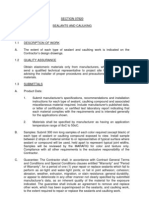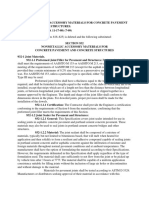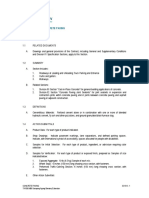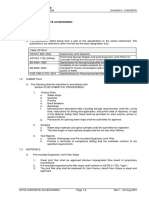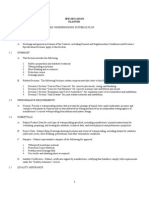ITCC in Riyadh Residential Complex J10-13300 07900-1 Sealants
ITCC in Riyadh Residential Complex J10-13300 07900-1 Sealants
Uploaded by
uddinnadeemCopyright:
Available Formats
ITCC in Riyadh Residential Complex J10-13300 07900-1 Sealants
ITCC in Riyadh Residential Complex J10-13300 07900-1 Sealants
Uploaded by
uddinnadeemOriginal Title
Copyright
Available Formats
Share this document
Did you find this document useful?
Is this content inappropriate?
Copyright:
Available Formats
ITCC in Riyadh Residential Complex J10-13300 07900-1 Sealants
ITCC in Riyadh Residential Complex J10-13300 07900-1 Sealants
Uploaded by
uddinnadeemCopyright:
Available Formats
SECTION 07900 SEALANTS 00000000PART 1 - GENERAL 1.1 SECTION INCLUDES A. 1.
2 Sealants required to make the construction weather and water tight as shown on drawings and as specified herein.
REFERENCES A. ASTM - American Society of Testing and Materials ASTM C 834 ASTM C 920 ASTM C 1330 ASTM D 1751 Specification for Latex Sealing Compounds Specification for Elastomeric Joint Sealants Specification for Cylindrical Sealant Backing for Use with Cold Liquid Applied Sealants Specification for Preformed Expansion Joint Fillers for Concrete Paving and Structural Construction (Non-extruding and Resilient Bituminous Types)
B.
FS - Federal Specifications FS-SS-S-200D-3 FS-TT-S-00227E-3 FS-TT-S-00230 Sealing Compounds, Two Component, Elastomeric, Polymer Type, Jet Fuel Resistant Cold Applied. Sealing Compound, Elastomeric Type, Multi-Component (for Caulking, Sealing, and Glazing in Building Construction Sealing Compound, Elastomeric Type, Single Component (for Caulking, Sealing, and Glazing in Buildings and Other Structures) Sealing Compound, Silicone Rubber Base (for Caulking, Sealing, and Glazing in Buildings and Other Structures Sealing Compound Single Component, Butyl Rubber Based, Solvent Release Type (for Buildings and Other Types of Construction
FS-TT-S-001543 FS-TT-S-001657
1.3
SUBMITTALS A. Product Data: Submit manufacturers technical data for each joint sealer required, including instruction for joint preparation and joint sealer application.
B.
Samples for Initial Selection Purposes: Submit the manufacturer's standard bead samples consisting of strips of actual products showing full range of colors available
07900-1 Sealants
ITCC in Riyadh Residential Complex J10-13300
for each product exposed to view. C. Samples for Verification Purposes: Submit samples of each type and color of joint sealer required. Install joint sealer samples in 12 mm wide joints formed between two 150 mm long strips of materials matching the appearance of exposed surfaces adjacent to joint sealers in the work. Certificates: Submit certificates from manufacturers of joint sealers attesting that products comply with specification requirements and are suitable for the use indicated.
D.
1.4
TRANSPORTATION, HANDLING AND STORAGE A. Deliver materials to Project site in original unopened containers or bundles with labels showing manufacturer, product name and designation, color, expiration period for use, pot life, curing time, and mixing instructions for multi-component materials. Store and handle materials in compliance with manufacturers' recommendations to prevent their deterioration or damage due to moisture, high or low temperatures, contaminants, or other causes.
B.
1.5
QUALITY ASSURANCE A. Mock-Ups: Prepare a mock-up of each different type of sealant installation shown. For each different condition shown, display in mock-up materials on each side of joint and sealant type installed. Approved mock-ups shall establish installation standards required for actual corresponding sealant work.
1.6
JOB CONDITIONS A. Do not proceed with installation of joint sealants unless requirements and manufacturer's instructions are satisfactory and applicable. Do not proceed with the installation of sealants under extreme temperature conditions which would cause joint openings to be at either maximum or minimum width or when such extreme temperatures or heavy wind loads are forecast during the period required for initial or nominal cure.
PART 2 - PRODUCTS 2.1 MATERIALS A. General: 1. Provide joint sealers, joint fillers and other related materials that are compatible with one another and with joint substrates under conditions of service and application, as demonstrated by the sealant manufacturer based on testing and field experience. Provide colors as indicated or, if not otherwise indicated, as selected by Engineer from the manufacturer's standard colors to comply with color board.
2.
ITCC in Riyadh Residential Complex J10-13300
07900-2
Sealants
3.
Where exposed to foot traffic, select marketed materials of sufficient strength and hardness to withstand traffic without damage or deterioration of sealant system.
B.
Types of Sealants: 1. Sealant No.1 - Multi-Component Polyurethane Sealant: Polyurethanebased, 2-part elastomeric sealant (non-sag), conforming to ASTM C 920, Type M, Grade NS, Class 25 or FS-TT-S-0227E, Type II, Class A. Sealant No.2 - One-Component Polyurethane Sealant: Polyurethanebased, one part elastomeric sealant (non-sag), conforming to ASTM C 920, Type M, Grade NS, Class 25. Sealant No.3 - One-Component Acrylic Sealant: Acrylic ter-polymer, solvent-based, one-part, thermo-plastic sealant complying ASTM C 834; solids not less than 95 percent acrylic as recommended by the manufacturer for general use as an exposed building construction sealant. Sealant No.4 - Two-Component Polyurethane Sealant: Pourable polyurethane-based, 2-part elastomeric sealant (self-leveling), conforming to ASTM C 920, Type M, Grade P, Class 25, or FS-TT-S-0220, or FS TT-S0227. Sealant No.5 - Mildew-Resistant Silicone Rubber Sealant: Silicone rubberbased, one part elastomeric sealant, conforming to ASTM C 920, Type S, Grade NS, Class 25 or FS TT-S-1543, Class A; specifically for mildew resistance and recommended by the manufacturer for interior joints in wet areas, passing ANSI A 136.1 test for mold growth. Sealant No.6 - One-component construction silicone sealant: Conforming to ASTM C 834 and ASTM C 920 with movement capability plus or minus 25 percent, excellent adhesion to glass and aluminum.
2.
3.
4.
5.
6.
2.2
MISCELLANEOUS MATERIALS A. B. Joint Primer/Sealer: Provide type of joint primer/ sealer recommended by sealant manufacturer for joint surfaces to be primed or sealed. Bond Breaker Tape: Polyethylene tape or other plastic tape as recommended by sealant manufacturer to be applied to sealant contact surfaces where bond to substrate or joint filler must be avoided for proper performance of sealant. Sealant Backer Rods: Preformed, compressible cylindrical sealant backings conforming to ASTM C 1330, open-cell polyethylene foam, polyurethane foam, butyl rubber foam, neoprene foam or other flexible, permanent, durable nonabsorptive material as recommended by sealant manufacturer for compatibility with sealant. Baker rods shall not be less than 25% thicker than the width of joint. Preformed Joint Filler Strips: Preformed joint filler strips shall be of asphalt saturated fiber board conforming to the requirements of ASTM D 1751. Provide joint filler strips of thickness and widths as shown on the drawings. Joint fillers for paving and structural construction shall be provided where shown on drawings.
C.
D.
ITCC in Riyadh Residential Complex J10-13300
07900-3
Sealants
PART 3 - EXECUTION 3.1 GENERAL A. Conform to sealant the manufacturer's printed installation instructions except where more stringent requirements are shown or specified, and except where manufacturer's authorized technical representative directs otherwise.
3.2
JOINT PREPARATION A. Clean out joints immediately before installing joint sealers to conform to the recommendations of joint sealer manufacturer as well as the following requirements: 1. Remove foreign material from joint substrates which could interfere with adhesion of joint sealer, including dust; paints, except for permanent, protective coatings tested and approved for sealant adhesion and compatibility by sealant manufacturer; old joint sealers; oil; grease; waterproofing; water repellant; water; surface dirt; and frost. Clean concrete, masonry, unglazed surfaces of ceramic tile and similar porous joint substrate surfaces, by brushing, grinding, blast cleaning, mechanical abrading, or a combination of these methods to produce a clean, sound substrate capable of developing optimum bond with joint sealers. Remove loose particles remaining from above cleaning operations by vacuuming or blowing out joints with oil-free compressed air. Remove laitance and form release agents from concrete. Clean metal, glass, porcelain enamel, glazed surfaces of ceramic tile; and other nonporous surfaces by chemical cleaners or other means which are not harmful to substrates or leave residues capable of interfering with adhesion of joint sealers.
2.
3.
4.
B.
Joint Priming: Prime joint substrates where indicated or where recommended by joint sealer manufacturer based on pre-construction joint sealer-substrate tests. Apply primer to comply with joint sealer manufacturer's recommendations. Confine primers to areas of joint sealer bond, do not allow spillage or migration onto adjoining surfaces.
3.3
INSTALLATION A. Set joint filler units with no voids or gaps between ends at proper depth of position in joint to coordinate with other work, including installation of bond breakers, backer rods, and sealants. Install sealant backer rod for sealants, except where joint filler strips are shown for the application indicated and as approved by Engineer. Install bond breaker tape between sealants and joint fillers where indicated and where required by manufacturer's recommendations to ensure that elastomeric sealants will perform properly. Except as otherwise indicated, fill sealant rabbet to a slightly concave surface slightly below adjoining surfaces. Where horizontal joints are between a horizontal
07900-4 Sealants
B. C. D.
ITCC in Riyadh Residential Complex J10-13300
surface and vertical surface, fill joint to form a slight cove, so that joint will not trap moisture and dirt. E. F. G. Seal joints before adjacent surfaces are waterproofed or painted. Install sealant to depths as shown or, if not shown, as recommended by sealant manufacturer. Spillage: Do not allow sealants or compounds to overflow or spill onto adjoining surfaces, or to migrate into voids of adjoining surfaces. Clean joint surfaces by whatever means may be necessary to eliminate evidence of spillage. Recess exposed edges of exposed joint fillers slightly behind adjoining surfaces, unless otherwise shown, so that compressed units will not protrude from joints. Bond ends of joint filler together with adhesive or weld by other means as recommended by the sealant manufacturer to ensure continuous watertight and airtight performance.
H. I.
3.4
SEALANT SCHEDULE A. At Contractor's option, provide one of the sealant types listed below for the corresponding joint type: 1. Exterior Joints: a. Joints between metal frame and concrete or masonry and joints between marble cladding: b. Sealant No.1 Sealant No.2
Expansion and control joints: Sealant No.1 Sealant No.2
c.
Exterior sills, jambs, and heads of window frames, door frames, louvers and similar openings and where metal, wood or other materials abut or join masonry concrete or each other: Sealant No.2 Sealant No.3
d.
Horizontal joints in pavement and sidewalks: Sealant No. 4
2.
Interior Joints: a. Interior sill, jamb, around window and door frames and all items adjoined to masonry or concrete surfaces. Sealant No.2
07900-5 Sealants
ITCC in Riyadh Residential Complex J10-13300
b.
Sealant No.3
Expansion and control joints: Sealant No. 1 Sealant No. 2
c.
aJoints between plumbing fixtures and other elements of wet areas: Sealant No. 5
3.
Exterior and Interior Glazing Sealant: Sealant No. 6
3.5
CLEANING AND PROTECTION A. B. Clean off sealants or sealant smears adjacent to joints as work progresses by methods and with cleaning materials approved by sealant manufacturers. Protect joint sealers during and after curing period from contact with contamination substances or damage resulting from construction operations or other causes so that they are without deterioration or damage at the time of Substantial Completion. END OF SECTION
ITCC in Riyadh Residential Complex J10-13300
07900-6
Sealants
You might also like
- Astm c717 - SelantesDocument13 pagesAstm c717 - SelantesJavier VianaNo ratings yet
- SSPC Pa 7 PDFDocument10 pagesSSPC Pa 7 PDFkishorekumar.animuNo ratings yet
- Generator MaintenanceDocument24 pagesGenerator MaintenancePablo Gaspar D'Agostini Amengual100% (11)
- 07920Document5 pages07920sethu1091No ratings yet
- Related SpecsDocument13 pagesRelated SpecsAhmed GhariebNo ratings yet
- Section 07920 Joint SealantsDocument7 pagesSection 07920 Joint SealantsMØhãmmed ØwięsNo ratings yet
- Division 7 Thermal and Moisture ProtectionDocument6 pagesDivision 7 Thermal and Moisture ProtectionndyyuliantoNo ratings yet
- SECTION 07 92 00 Joint SealantsDocument14 pagesSECTION 07 92 00 Joint SealantsDemir YurdakulNo ratings yet
- Joint Sealants - MSTDocument9 pagesJoint Sealants - MSTwafikmh4No ratings yet
- 03410Document5 pages03410Jeffrey Carlo Viduya AgliamNo ratings yet
- 07910Document3 pages07910sethu1091No ratings yet
- SECTION 07 92 00 Joint SealantsDocument13 pagesSECTION 07 92 00 Joint SealantsJuanPaoloYbañezNo ratings yet
- Façade SealantsDocument3 pagesFaçade Sealantsrached abboudNo ratings yet
- ITCC in Riyadh Residential Complex J10-13300 07150-1 DampproofingDocument3 pagesITCC in Riyadh Residential Complex J10-13300 07150-1 DampproofinguddinnadeemNo ratings yet
- Section 07920 Joint SealantsDocument10 pagesSection 07920 Joint Sealantsjcunha4740No ratings yet
- Sealant ProcedureDocument7 pagesSealant ProcedureNESTOR YUMULNo ratings yet
- SECTION 07 18 13 Pedestrian Traffic CoatingsDocument4 pagesSECTION 07 18 13 Pedestrian Traffic CoatingsJuanPaoloYbañezNo ratings yet
- ITCC in Riyadh Residential Complex J10-13300 09671-1 Resinous FlooringDocument4 pagesITCC in Riyadh Residential Complex J10-13300 09671-1 Resinous FlooringuddinnadeemNo ratings yet
- SS9320000Document7 pagesSS9320000Sweta GuptaNo ratings yet
- Section - 07 92 00 - Sealants and CaulkingDocument4 pagesSection - 07 92 00 - Sealants and CaulkingEliseo LagmanNo ratings yet
- 07 91 26 SealantDocument10 pages07 91 26 SealantshajbabyNo ratings yet
- Guide Specification: NeoflexDocument4 pagesGuide Specification: NeoflexruloNo ratings yet
- Key IWS CoatingDocument6 pagesKey IWS Coatingfaisal hanifNo ratings yet
- University of Houston Master Construction Specifications Insert Project NameDocument5 pagesUniversity of Houston Master Construction Specifications Insert Project NameTaher AmmarNo ratings yet
- 13 WaterProofDocument4 pages13 WaterProofadel agustiNo ratings yet
- University of Houston Master Construction SpecificationsDocument5 pagesUniversity of Houston Master Construction SpecificationsTaher AmmarNo ratings yet
- Section 035216 - Lightweight Insulating ConcreteDocument5 pagesSection 035216 - Lightweight Insulating ConcreteWENDING HUNo ratings yet
- Specifications Vapor Barrier/Dampproofing (Ecodamp)Document6 pagesSpecifications Vapor Barrier/Dampproofing (Ecodamp)Baugh Graphic DesignNo ratings yet
- SECTION 03251 Expansion and Construction Joints: Part 1 GeneralDocument4 pagesSECTION 03251 Expansion and Construction Joints: Part 1 GeneralJojolasNo ratings yet
- Guide Specification Walls, Interior, Wood or Metal Studs, Cementitious Backer Unit, Latex-Portland Cement Mortar, TCNA W244C-07Document5 pagesGuide Specification Walls, Interior, Wood or Metal Studs, Cementitious Backer Unit, Latex-Portland Cement Mortar, TCNA W244C-07alex_geus5080No ratings yet
- 09 25 13 - Acrylic Plastering PDFDocument8 pages09 25 13 - Acrylic Plastering PDFmasoodaeNo ratings yet
- Section 321313 - Concrete Paving: Part 1 - GeneralDocument13 pagesSection 321313 - Concrete Paving: Part 1 - Generalery achjariNo ratings yet
- Section 03150-Concrete AccessoriesDocument3 pagesSection 03150-Concrete AccessoriesMØhãmmed ØwięsNo ratings yet
- Draft - SPECIFICATIONS - CONCRETE SLAB ON GRADE OVER PARTIALLY MILLED ASPHALT PAVEMENTDocument5 pagesDraft - SPECIFICATIONS - CONCRETE SLAB ON GRADE OVER PARTIALLY MILLED ASPHALT PAVEMENTMohammed FasilNo ratings yet
- Section 07572 Athletic Surface 3Document4 pagesSection 07572 Athletic Surface 3bravo deltafoxNo ratings yet
- Plastic Glazing SpecsDocument9 pagesPlastic Glazing SpecsJacob PriyadharshanNo ratings yet
- 035416-Hydraulic UnderlaymentDocument4 pages035416-Hydraulic UnderlaymentGhayas JawedNo ratings yet
- (JV2) 079200 Joint SealantsDocument16 pages(JV2) 079200 Joint Sealantsodongo johnNo ratings yet
- Specification Blindside Waterproofing With BentoniteDocument9 pagesSpecification Blindside Waterproofing With BentoniteBaugh Graphic DesignNo ratings yet
- Nichiha NichiSoffit 3 Part SpecDocument6 pagesNichiha NichiSoffit 3 Part SpecSaraly ChamorroNo ratings yet
- ITCC in Riyadh Residential Complex J10-13300 09660-1 Resilient FlooringDocument5 pagesITCC in Riyadh Residential Complex J10-13300 09660-1 Resilient FlooringuddinnadeemNo ratings yet
- Portland Cement Plaster (Stucco) Applied To Framed Walls (2/2017)Document13 pagesPortland Cement Plaster (Stucco) Applied To Framed Walls (2/2017)Salim HmzNo ratings yet
- CCCC Et Ha Spec ST 650 00 Reply BDocument5 pagesCCCC Et Ha Spec ST 650 00 Reply B黄赛赛No ratings yet
- Joints For Concrete Pipe, Manholes, and Precast Box Sections Using Preformed Flexible Joint SealantsDocument4 pagesJoints For Concrete Pipe, Manholes, and Precast Box Sections Using Preformed Flexible Joint SealantsRenish Regi100% (1)
- Nu - 07 9200 - Joint SealantsDocument13 pagesNu - 07 9200 - Joint Sealantsmohamed redaNo ratings yet
- SECTION 03315 GroutDocument5 pagesSECTION 03315 GroutFurgoToyotaNo ratings yet
- M - Series Specification 02 - 2018Document5 pagesM - Series Specification 02 - 2018Ahsan KhanNo ratings yet
- Section 07141 Cold Fluid Applied WaterproofingDocument6 pagesSection 07141 Cold Fluid Applied WaterproofingMØhãmmed ØwięsNo ratings yet
- 62 Percent Open Surface Area FRP Molded Grating SpecsDocument6 pages62 Percent Open Surface Area FRP Molded Grating SpecsSubhadip RoyNo ratings yet
- KOSTER NB1 Grey Specification For Cementitious Crystallizing WaterproofingDocument7 pagesKOSTER NB1 Grey Specification For Cementitious Crystallizing WaterproofingMosul SpaceNo ratings yet
- Concrete RehabilitationDocument5 pagesConcrete Rehabilitationjack.simpson.changNo ratings yet
- SYS3PDocument6 pagesSYS3PBaugh Graphic DesignNo ratings yet
- ITCC in Riyadh Residential Complex J10-13300 05810-1 Expansion Joint Cover AssembliesDocument5 pagesITCC in Riyadh Residential Complex J10-13300 05810-1 Expansion Joint Cover AssembliesuddinnadeemNo ratings yet
- Modif Bitum Sheet Air BarriersDocument5 pagesModif Bitum Sheet Air BarriersTaher AmmarNo ratings yet
- Guide Specification Shower Receptors, Wood or Metal Studs, Cement Mortar TCNA B414-07Document5 pagesGuide Specification Shower Receptors, Wood or Metal Studs, Cement Mortar TCNA B414-07alex_geus5080No ratings yet
- GRC SpecDocument8 pagesGRC SpecOttawa CanadaNo ratings yet
- Residential Asphalt Roofing Manual Design and Application Methods 2014 EditionFrom EverandResidential Asphalt Roofing Manual Design and Application Methods 2014 EditionNo ratings yet
- Advances in Ceramic Armor XFrom EverandAdvances in Ceramic Armor XJerry C. LaSalviaNo ratings yet
- Spot Welding Interview Success: An Introduction to Spot WeldingFrom EverandSpot Welding Interview Success: An Introduction to Spot WeldingNo ratings yet
- Electrical Engineer CV (M Bilal M)Document4 pagesElectrical Engineer CV (M Bilal M)uddinnadeemNo ratings yet
- XXXXXX: Voltage Drop& Cable Sizing CalculationsDocument5 pagesXXXXXX: Voltage Drop& Cable Sizing CalculationsPradeesh Vijayan (v.prathi)No ratings yet
- Panel Board ShortCircuit RatingsDocument2 pagesPanel Board ShortCircuit RatingsuddinnadeemNo ratings yet
- Where Indicated Supply and Apply On Concrete Screed A Multi Component Hard Wearing, Smooth, Matt or Satin Finish Polyurethane Based Flooring System at A Thickness of 2.5 MM UtilisingDocument1 pageWhere Indicated Supply and Apply On Concrete Screed A Multi Component Hard Wearing, Smooth, Matt or Satin Finish Polyurethane Based Flooring System at A Thickness of 2.5 MM UtilisinguddinnadeemNo ratings yet
- Panel Board ShortCircuit RatingsDocument2 pagesPanel Board ShortCircuit RatingsuddinnadeemNo ratings yet
- Green Grounding ManualDocument23 pagesGreen Grounding Manualuddinnadeem100% (1)
- Nicet AlarmsDocument23 pagesNicet AlarmsWERMERMNo ratings yet
- SECTION 01300 Submittals 1.01 General: Vocational Training CenterDocument11 pagesSECTION 01300 Submittals 1.01 General: Vocational Training CenterulyjohnignacioNo ratings yet
- Submittal ReviewDocument22 pagesSubmittal ReviewuddinnadeemNo ratings yet
- 15400Document27 pages15400uddinnadeemNo ratings yet
- 16715-Voice & Data CablingDocument16 pages16715-Voice & Data Cablinguddinnadeem100% (1)
- Lightning ProtectionDocument3 pagesLightning ProtectionuddinnadeemNo ratings yet
- 16721-Fa SystemDocument17 pages16721-Fa SystemuddinnadeemNo ratings yet
- 16716-Voice & Data SystemDocument13 pages16716-Voice & Data SystemuddinnadeemNo ratings yet
- 16504-Home Automation SystemDocument23 pages16504-Home Automation SystemuddinnadeemNo ratings yet
- 16461-Dry Type TransformerDocument8 pages16461-Dry Type TransformeruddinnadeemNo ratings yet
- ITCC in Riyadh Residential Complex J10-13300 16610-1 UPSDocument6 pagesITCC in Riyadh Residential Complex J10-13300 16610-1 UPSuddinnadeemNo ratings yet
- LightingDocument13 pagesLightinguddinnadeemNo ratings yet
- Panel BoardDocument7 pagesPanel BoarduddinnadeemNo ratings yet
- 16453-Grounding & Bonding Telecommunication SystemDocument6 pages16453-Grounding & Bonding Telecommunication SystemuddinnadeemNo ratings yet
- 16342-Metal Clad MV SWGRDocument14 pages16342-Metal Clad MV SWGRuddinnadeemNo ratings yet
- GroundingDocument6 pagesGroundinguddinnadeemNo ratings yet
- Package SubstationDocument9 pagesPackage SubstationuddinnadeemNo ratings yet
- 16410-Swiches & CBDocument15 pages16410-Swiches & CBuddinnadeemNo ratings yet
- GeneratorDocument19 pagesGeneratoruddinnadeemNo ratings yet
- BuswayDocument5 pagesBuswayuddinnadeemNo ratings yet



